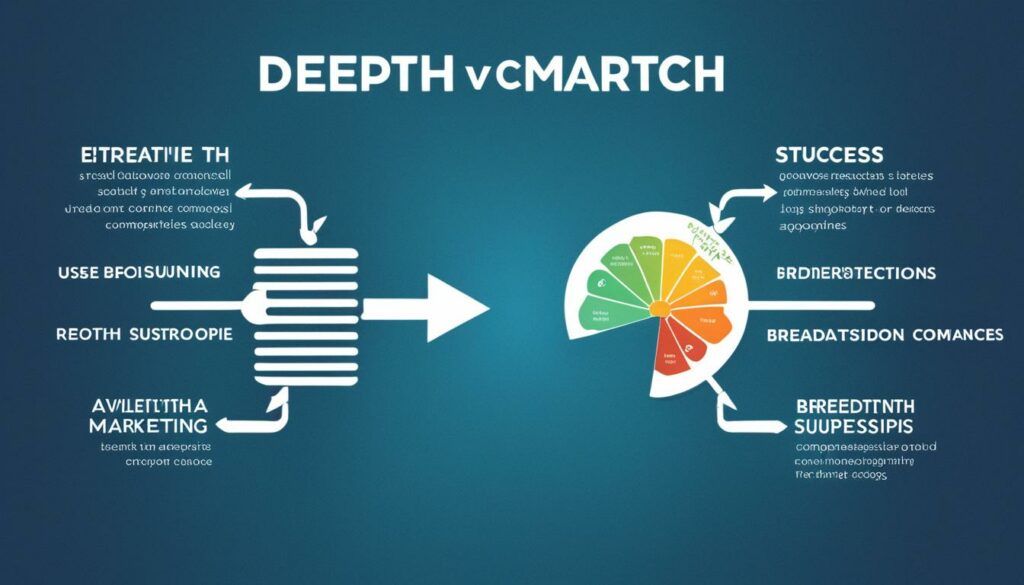In today’s highly competitive business landscape, marketing strategies play a crucial role in the success of any brand. When it comes to developing a comprehensive marketing plan, marketers often face a fundamental choice: breadth vs depth marketing. These two approaches represent different methods of reaching and engaging with target audiences. In this article, we will explore the key differences between breadth and depth marketing strategies and help you determine which approach is best suited for your brand’s goals.
Key Takeaways:
- Breadth marketing focuses on reaching a wide audience and provides a diverse range of products or services.
- Depth marketing targets a specific niche market and offers a more tailored and personalized offering.
- Key factors to consider when choosing between breadth and depth marketing include target audience and product assortment.
- Breadth marketing increases brand visibility and market share, while depth marketing fosters brand loyalty and a strong market position.
- Successful examples of breadth marketing include Amazon and Walmart, while Tesla and Apple are renowned for their depth marketing strategies.
What is Breadth Marketing?
Breadth marketing is a strategic approach that aims to reach a wide audience and offer a diverse range of products or services. This marketing strategy involves casting a wide net and targeting a broad demographic to capture as many potential customers as possible.
With breadth marketing, businesses focus on providing a comprehensive product assortment that caters to a variety of needs and preferences. By offering a wide range of products or services, brands can increase their visibility and attract a larger audience.
Breadth marketing also involves broad targeting, where marketers aim to reach a wide demographic of consumers rather than narrowing their focus to a specific niche. This approach allows businesses to maximize their market share and tap into new markets.
Implementing a breadth marketing strategy can be beneficial in expanding brand visibility, attracting new customers, and increasing overall market share. By targeting a wide audience and offering a diverse product range, businesses can position themselves as a one-stop destination for various customer needs.
What is Depth Marketing?
Depth marketing is a strategy that involves targeting a specific niche and providing a more tailored and specialized offering. Instead of casting a wide net, depth marketing focuses on deeply understanding the needs and preferences of a specific target audience. This approach allows marketers to develop a more personalized and differentiated product or service that resonates with the specific desires of their niche market. Depth marketing can be effective in building brand loyalty, establishing a strong market position, and fostering long-term customer relationships.
Key Features of Depth Marketing:
- Specific Niche: Depth marketing targets a narrow audience segment with precise characteristics, allowing for highly relevant messaging and positioning.
- Tailored Offering: Through in-depth market research and analysis, depth marketers create products or services that cater to the unique needs and preferences of their niche audience.
- Focused Marketing Approach: Depth marketers concentrate their efforts and resources on a specific market segment, allowing for more effective messaging and communication.
- Building Brand Loyalty: By delivering specialized solutions tailored to their audience, depth marketing cultivates strong brand loyalty, resulting in repeat business and positive word-of-mouth.
Implementing a depth marketing strategy involves thorough audience research, establishing a unique value proposition, and crafting messaging and positioning that resonates with the specific niche. By focusing on depth rather than breadth, businesses can position themselves as industry leaders within their targeted niche, delivering exceptional value and experiences to their customers.
Key Differences Between Breadth and Depth Marketing
When it comes to marketing strategies, there are key differences between breadth marketing and depth marketing. Understanding these differences is crucial in determining the most effective approach for your brand. Let’s take a closer look at the distinctions between the two strategies:
Breadth Marketing
- Targets a wide audience
- Offers a diverse range of products or services
- Aims to maximize market share
Depth Marketing
- Targets a specific niche
- Provides a more tailored and specialized offering
- Focuses on establishing a strong market position
By comprehending these fundamental differences, brands can make informed decisions about their marketing strategy. Whether you choose to cast a wide net with breadth marketing or focus on a specific niche with depth marketing, both approaches have their unique advantages. Ultimately, it depends on your brand’s goals, target audience, and resources.
Now let’s delve deeper into each strategy to gain a better understanding of their benefits and considerations.
Benefits of Breadth Marketing
Breadth marketing offers several benefits for businesses. By targeting a wide audience, breadth marketing increases brand visibility and exposure. It allows businesses to reach new markets and expand their customer base. Additionally, offering a diverse range of products or services can attract a larger customer base and increase market share. Breadth marketing also provides flexibility and adaptability, as businesses can easily adjust their offerings to meet changing market demands.
To illustrate the benefits of breadth marketing, let’s take a closer look at some real-world examples:
Increased Brand Visibility
One of the key advantages of breadth marketing is the ability to enhance brand visibility. By targeting a wide audience, businesses can ensure that their brand and offerings are seen by a larger number of potential customers. This increased visibility helps to create brand recognition and familiarity, making it more likely that customers will choose their products or services over competitors.
Expanded Customer Base
Breadth marketing enables businesses to tap into new markets and expand their customer base. By casting a wider net, companies can attract customers from different demographics, regions, or segments. This diversification of the customer base not only increases market reach but also reduces the reliance on a single target market, making the business less susceptible to market fluctuations or changes in customer preferences.
Increased Market Share
Offering a diverse range of products or services through breadth marketing can help businesses capture a larger market share. By catering to a wide audience with varying needs and preferences, companies can attract more customers and gain a competitive edge. This broader customer base can lead to increased sales and revenue, ultimately boosting the overall market share.
Implementing a breadth marketing strategy can provide businesses with numerous advantages, including increased brand visibility, an expanded customer base, and an increased market share. However, it’s important to carefully evaluate the marketing landscape and consider other factors before deciding on the most suitable approach for your brand.
Benefits of Depth Marketing
Depth marketing offers unique advantages for businesses targeting a specific niche. By focusing on a specific audience, depth marketing allows businesses to develop a deeper understanding of their customers’ needs and preferences. This enables them to create a more tailored and personalized offering, which can lead to increased brand loyalty and customer satisfaction. Depth marketing also allows businesses to establish a strong market position within their niche, making it harder for competitors to replicate their success.
Implementing a depth marketing strategy can have numerous benefits for your business:
- Targeted Approach: Depth marketing enables businesses to concentrate their efforts on a specific audience or niche, allowing for a more targeted approach. By understanding the unique needs and preferences of their target market, businesses can create tailored marketing campaigns, products, and services that resonate with their customers.
- Increased Brand Loyalty: By catering to the specific desires of their niche market, businesses can foster strong brand loyalty. When customers feel that a company understands and meets their individual needs, they are more likely to remain loyal to that brand and become repeat customers.
- Enhanced Customer Satisfaction: Through depth marketing, businesses can provide a more personalized and differentiated customer experience. By offering products and services that are specifically designed with their target audience in mind, businesses can exceed customer expectations and increase overall satisfaction.
- Strong Market Position: Depth marketing allows businesses to position themselves as experts within their niche. By focusing their resources and efforts on a specific target market, businesses can establish themselves as the go-to provider for their products or services. This helps to build credibility, trust, and a solid reputation within the industry.
To illustrate the benefits of depth marketing, let’s take a closer look at a table comparing breadth marketing and depth marketing:
| Breadth Marketing | Depth Marketing | |
|---|---|---|
| Target Audience | Wide audience | Specific niche |
| Product Offering | Diverse range | Tailored and specialized |
| Brand Loyalty | Varies | Increased |
| Market Position | Varies | Established and strong |
This table clearly demonstrates the unique benefits of depth marketing, including a more targeted approach, increased brand loyalty, enhanced customer satisfaction, and a strong market position within a specific niche.
Factors to Consider When Choosing Between Breadth and Depth Marketing
When deciding between breadth and depth marketing, several factors should be considered:
- Assess your target audience and their specific needs.
- If your target audience is broad and diverse, breadth marketing may be more effective.
- However, if you have identified a specific niche with unique demands, depth marketing may be the better choice.
- Evaluate your product assortment and determine if a wide range of offerings or a more specialized offering aligns with your brand’s strengths and capabilities.
Understanding these factors will help you make an informed decision on whether breadth marketing or depth marketing is the most suitable strategy for your brand.
| Breadth Marketing | Depth Marketing | |
|---|---|---|
| Target Audience | Wide audience | Specific niche |
| Product Assortment | Diverse range of offerings | Specialized and tailored offering |
| Market Focus | Maximizing market share | Establishing a strong market position |
| Benefits | Increased brand visibility, Reaching new markets |
Building brand loyalty, Fostering long-term customer relationships |
Implementing a Breadth Marketing Strategy
To effectively implement a breadth marketing strategy, it is essential to focus on developing a comprehensive product assortment that caters to a wide range of customer needs and preferences. By offering a diverse range of products, you can attract a broader audience and increase your brand’s visibility in the market.
Expanding your target audience is another crucial aspect of implementing a successful breadth marketing strategy. This can be achieved through various marketing channels, such as:
- Digital advertising
- Social media marketing
- Traditional advertising methods
By utilizing a mix of these marketing channels, you can reach a wider audience and increase your brand’s exposure. Additionally, consider leveraging partnerships and collaborations with other businesses to enter new markets and expand your customer base.
Continuously monitoring and analyzing market trends is vital in ensuring that your breadth marketing strategy remains effective and aligned with evolving customer demands. Regularly collect and analyze customer feedback to gain insights into their preferences and expectations.
Implementing a breadth marketing strategy entails the following:
- Developing a comprehensive product assortment
- Expanding your target audience using various marketing channels
- Utilizing partnerships and collaborations
- Continuously monitoring and analyzing market trends and customer feedback
| Benefits of Implementing a Breadth Marketing Strategy |
|---|
| Increased brand visibility |
| Expanded target audience |
| Maximized market share |
| Flexibility and adaptability |
Implementing a Depth Marketing Strategy
Implementing a depth marketing strategy requires a comprehensive understanding of your target niche audience. To effectively reach this niche audience, you need to conduct in-depth market research to gain valuable insights into their specific needs, preferences, and pain points. By analyzing this information, you can develop a unique and personalized offering that caters specifically to their desires.
To effectively reach your niche audience, it is crucial to utilize targeted marketing channels and messaging. By employing strategies such as targeted online advertising, customized email campaigns, and niche-specific social media content, you can ensure that your marketing messages resonate with your audience and drive engagement.
Collecting and analyzing customer feedback is an essential aspect of implementing a successful depth marketing strategy. By actively seeking feedback from your niche audience, you can gain valuable insights into their experiences, preferences, and areas for improvement. This feedback allows you to continually refine and enhance your depth marketing strategy, ensuring it remains aligned with the evolving needs and expectations of your niche audience.
| Benefits of Implementing a Depth Marketing Strategy |
|---|
| 1. Increased brand loyalty and customer satisfaction |
| 2. Enhanced market position within the niche |
| 3. Higher chances of long-term customer relationships |
| 4. Improved targeting and relevance of marketing efforts |
| 5. Opportunities for differentiation and competitive advantage |
By implementing a depth marketing strategy, you can establish strong connections with your niche audience, build brand loyalty, and position your brand as a leader within your specific market segment. Continuously monitor market trends, adapt your strategy, and leverage customer feedback to ensure the ongoing success of your depth marketing efforts.
Case Studies: Successful Breadth and Depth Marketing Examples
Several successful companies have implemented either breadth or depth marketing strategies to achieve their marketing objectives. Case studies of these companies can provide valuable insights and inspiration for businesses looking to optimize their marketing approach.
Examples of Successful Breadth Marketing
One example of successful breadth marketing is Amazon. The company offers a wide range of products spanning various categories, including electronics, books, and clothing. By catering to diverse customer needs, Amazon has been able to reach a wide audience and establish itself as a leading e-commerce platform.
Another example is Walmart. With its extensive product assortment that includes groceries, household items, and apparel, Walmart appeals to a broad demographic. The company’s breadth marketing strategy has helped it become a retail giant, capturing a significant market share and attracting millions of customers worldwide.
Examples of Successful Depth Marketing
Tesla is an excellent example of successful depth marketing. The company focuses on a specific niche of electric vehicles, positioning itself as a pioneer in the industry. Through its innovative technology and unique design, Tesla has cultivated a loyal customer base that is passionate about sustainability and cutting-edge automotive technology.
Apple is another company that has excelled in depth marketing. By targeting a specific niche of premium smartphones, tablets, and computers, Apple has built a powerful brand and a cult-like following. The company’s commitment to sleek design, user-friendly interfaces, and seamless integration across devices has made it a leader in the technology industry.

| Company | Marketing Strategy |
|---|---|
| Amazon | Breadth Marketing |
| Walmart | Breadth Marketing |
| Tesla | Depth Marketing |
| Apple | Depth Marketing |
Evaluating and Choosing the Right Marketing Strategy for Your Brand
When it comes to marketing your brand, choosing the right strategy is essential for success. Evaluating your options and understanding your brand goals and target market are crucial factors in making an informed decision. By assessing your resources, capabilities, and market trends, you can determine which marketing strategy aligns best with your brand’s strengths.
One important step is conducting thorough market research to gather insights on your target audience. Understanding their needs, preferences, and behaviors will help you tailor your marketing efforts effectively. By evaluating your competition and industry trends, you can identify any gaps or opportunities that can give your brand a competitive edge.
It’s important to carefully weigh the advantages and considerations of breadth and depth marketing strategies. A breadth marketing strategy can help you reach a wide audience and maximize market share. On the other hand, a depth marketing strategy allows for a more personalized and tailored approach to cater to a specific niche.
By analyzing and considering these factors, you can select the marketing strategy that will maximize your brand’s reach and engagement. Whether you choose a breadth or depth marketing strategy, remember to continuously monitor and adapt your approach to stay aligned with evolving market trends and customer preferences.
Conclusion
The choice between breadth and depth marketing strategies ultimately depends on your brand’s goals, target audience, and resources. Breadth marketing offers the advantage of reaching a wide audience and maximizing market share, while depth marketing allows for a more personalized and specialized approach to cater to a specific niche.
When evaluating these strategies, consider the benefits of breadth marketing, such as increasing brand visibility and reaching new markets. On the other hand, depth marketing can help build brand loyalty and establish a strong market position within a specific niche.
To optimize your brand’s reach and engagement, carefully analyze your target audience, market trends, and competition. Determine which strategy aligns best with your brand’s strengths and resources. Remember to continually analyze and adapt your marketing approach to stay aligned with evolving customer preferences and market dynamics.
FAQ
What is breadth marketing?
Breadth marketing refers to a marketing strategy that aims to reach a wide audience and offer a diverse range of products or services.
What is depth marketing?
Depth marketing involves targeting a specific niche and providing a more tailored and specialized offering.
What are the key differences between breadth and depth marketing?
Breadth marketing focuses on reaching a wide audience and offering a diverse range of products, while depth marketing targets a specific niche and provides a more tailored offering.
What are the benefits of breadth marketing?
Breadth marketing increases brand visibility, reaches new markets, and maximizes overall market share.
What are the benefits of depth marketing?
Depth marketing allows for a more personalized and differentiated offering, leading to increased brand loyalty and market position within a niche.
What factors should be considered when choosing between breadth and depth marketing?
Factors such as target audience, product assortment, and brand goals should be taken into account when deciding on a marketing strategy.
How can a breadth marketing strategy be implemented?
To implement a breadth marketing strategy, businesses should develop a comprehensive product assortment and expand their target audience through various marketing channels.
How can a depth marketing strategy be implemented?
Implementing a depth marketing strategy involves identifying and understanding a target niche audience, developing a personalized offering, and utilizing targeted marketing channels.
Can you provide examples of successful breadth marketing?
Examples of successful breadth marketing include companies like Amazon and Walmart, which offer a wide range of products to cater to diverse customer needs.
Can you provide examples of successful depth marketing?
Examples of successful depth marketing include companies like Tesla and Apple, which have built a strong brand and customer loyalty within specific niches.
How can I evaluate and choose the right marketing strategy for my brand?
Evaluate your brand goals, target market, resources, and industry trends to determine which strategy aligns best with your brand’s strengths.




